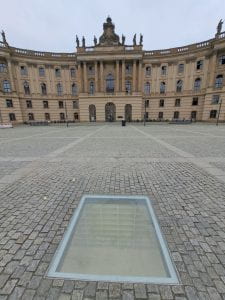Berlin is filled with historical sites relating to World War II. After the Battle of Berlin, much of the city was destroyed by Allied bombing. Berlin had to be rebuilt. However, some of the destruction is still on display in the form of museums and memorials. The creation of national museums and memorials on sites previously critical to the Nazi regime help the German people confront their crimes. Before the Nazis seized power in 1933, the Bundestag was the building that housed the German Parliament. Adolf Hitler and many other Nazis were members of Parliament during this time. However, once the Nazi regime was established in Germany, the Bundestag was used to house the offices of high-ranking Nazi officials. Now, the Bundestag stands as a symbol of German democracy. This is one way the German people strive to establish a collective memory of World War II—one that deals with guilt and justice.
The Bundestag was invaded by the Soviet Red Army in early May 1945 during the Battle of Berlin. Capturing the Reichstag was a very symbolic victory for the Allied forces. The bullet holes from the battle are still on display today. Also still visible is the graffiti that Soviet soldiers left on the outside of the building. Leaving the evidence of the Battle of Berlin reminds the German people of the atrocities of World War II.

Soviet Etchings in the Reichstag Building
An art piece inside the Bundestag named Archive of German Members of Parliament by Christian Boltanski demonstrates this idea well. Boltanski, a French Jew, created the piece in 1999. It consists of around 5,000 metal boxes that display the democratically elected members of German Parliament from 1919 to 1999. It includes those members of Parliament who were murdered during the Nazi regime while also including those who were members of the National Socialist Party. Therefore, while it commemorates the achievements of German parliamentary history, it also takes witness to its failures. In this way, the German people remember the terror of the Nazi party, while also bearing witness to their own guilt in supporting the Nazis.

The Archive of German Members of Parliament





 The exhibits then progress through the rise of the SS in Germany and the victims of the brutal organization. As the SS rose along with the backing of the Nazi Party, Germans who supported the regime effectively supported the SS. This support for the Nazi Party also supported the SS concentration camps, extermination camps, and the continuance of the organization’s extra-legal status. After the war, many claimed that the Nazi regime’s oppressive control left Germans no choice but to engage in its genocidal policies; however, exhibits such as the ones displayed in the Topography of Terror refute this claim. With the seemingly unanimous support that the Nazi Party had, it is certain that many supported the SS as well, not only due to the oppressive control of the regime.
The exhibits then progress through the rise of the SS in Germany and the victims of the brutal organization. As the SS rose along with the backing of the Nazi Party, Germans who supported the regime effectively supported the SS. This support for the Nazi Party also supported the SS concentration camps, extermination camps, and the continuance of the organization’s extra-legal status. After the war, many claimed that the Nazi regime’s oppressive control left Germans no choice but to engage in its genocidal policies; however, exhibits such as the ones displayed in the Topography of Terror refute this claim. With the seemingly unanimous support that the Nazi Party had, it is certain that many supported the SS as well, not only due to the oppressive control of the regime.




























